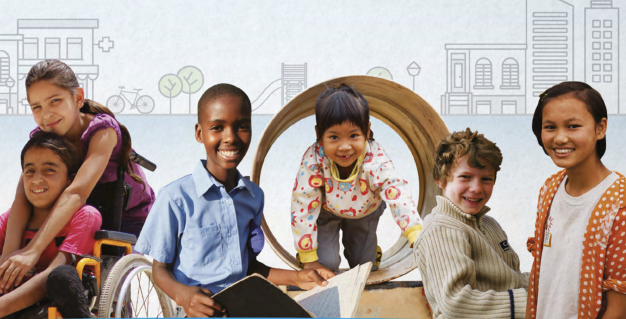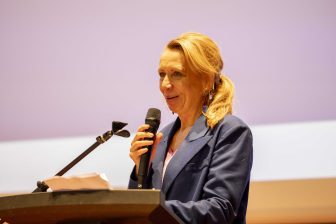
Child in the City Brussels 2023 – Q&A with keynote speaker Mona Meienberg of UNICEF
As we count down to our eagerly-awaited Child in the City World Conference in Brussels in November, child professionals from across the globe are preparing to join us and share their knowledge.
We’re delighted therefore to introduce to you today one of our opening day keynote speakers, Mona Meienberg (pictured below) of the global children’s charity UNICEF. Mona tells us about the definition of a ‘child friendly city’, and what it looks like in reality.
What is your role and where are you based?
I’m leading the division of Child Friendly Community and City Development at UNICEF Switzerland and Liechtenstein and am based in Zurich, Switzerland. In this role I’m responsible for the implementation of UNICEF’s worldwide ‘‘Child Friendly Cities initiative’ (CFCI), as well as the thematic area of child friendly living spaces.
Can you please give an overview of your career history to date in so far as it relates to children?
I hold a masters degree in political science and international law from the University of Berne and Aarhus University (Denmark). During my studies I worked in a law firm, specialised on migration and refugee law and volunteered at Amnesty International. Additionally, I was employed by UNICEF Switzerland in 2017 on a mandate basis, where I was responsible for assessing the child rights situation at the municipality level. I officially joined UNICEF in 2018 and am leading the Child Friendly Community and City Development division since the beginning of 2022.

In your own words, what would you say is the definition of a ‘child friendly city’?
A child friendly community or city puts children’s rights at the heart of its local development strategy. This means that a municipality commits to guarantee all children all of their rights at all times, as ensured in Article 2 of the UN Convention on the Rights of the Child. It also means that children are involved in decision-making processes, meaning that communities are not only built for children but together with children. By empowering children to speak up we’re giving them a voice and therefore strengthen democracy as whole.
Is there a particular area of your work that you are passionate about and which drives and/or inspires you?
The implementation of children’s rights is not ‘nice to have’ but binding. Almost all countries in the world have ratified the UN Convention on the Rights of the Child and thus committed themselves to its implementation. It is universally recognised that children and young people need a framework that protects, promotes and enables them to participate. Unfortunately, most of the signatory states do not fulfil this obligation fully. With my work, I aim at making a positive change and make the implementation of children’s rights a reality.
What benefits does being named ‘child friendly’ bring to a city/municipality that is awarded this status?
Communities and cities working together with UNICEF are given a tool that supports local governments with the implementation of children’s rights at the municipality level. Through a proven and recognised process, child-friendliness is implemented in a sustainable and systematic way. Child-friendliness should not depend on the commitment of a single person, but it needs the political will and commitment of the municipality as a whole.
Child-friendliness should not depend on the commitment of a single person, but it needs the political will and commitment of the municipality as a whole.
UNICEF’s ‘Child Friendly Cities Initiative’ ensures this with its global perspective and its strong expertise in the areas of children’s rights and child and youth participation. For some communities, this title also increases the attractiveness of the municipality as a place to live for families and can therefore be seen as a seal of quality. For UNICEF, however, the process and the political commitment are clearly in the centre of the partnership with a municipality.
How does UNICEF measure the effectiveness of a city in being ‘child friendly’ once it has been formally recognised? Are there certain tangible successes that UNICEF looks for as part of its monitoring process?
UNICEF has developed a monitoring and evaluation framework, which can be adapted to any national/local context. As the process is repeated every four years and municipalities have to renew the label, they are constantly evolving. The municipalities submit regular reports on the status of implementation. UNICEF also holds regular discussions with the communities and also conducts regular internal and external evaluations to ensure that the quality of the initiative can be maintained respectively continuously improved.
‘UNICEF holds regular discussions with the communities’
The annual evaluations among the participating ‘Child Friendly Cities’ show that the initiative is achieving visible results for children and young people and therefore have a positive impact on children. This is particularly the case in the anchoring of child-friendliness as a cross-sectional task, the participation of children and young people and child-friendly budgeting.
Do you agree that learning from best practice and the experiences of others is a vital component in how cities can look to shape children’s futures?
I prefer to avoid the word ‘best’ when referring to examples of successfully implementing children’s rights. I prefer to refer to them as ‘good’ examples because an example might be best in a specific context and environment but not in another. I do, however, agree that exchanging with and learning from each other is crucial and also allows us to use our resources wisely. Many communities and cities I’ve worked together with face similar challenges in regard to the implementation of children’s rights at the local but also national level. Yet, political systems and population sizes, for example, differ and therefore any example of a city has to be adapted to one’s own and specific context.
Do we, as a society, listen enough to the views of children and young people when developing policies that are designed to affect their lives?
Not at all. Studies, reports but also my personal experience show that children and their views are often not considered. Often this does not happen maliciously, but because those responsible do not know any better. They often do not know how to consider, translate and implement the children’s opinion in concrete results for children. But often adults also think that children cannot seriously assess the consequences or do not see the bigger picture.
Often adults also think that children cannot seriously assess the consequences or do not see the bigger picture.
Or they lack the necessary time and expertise to involve children. If children are listened to, then it is perhaps when it comes to building a playground. Something concrete and visible. But certainly not policies, guidelines or strategies.
How can cities best ensure that all the stakeholders involved in improving children’s lives, such as central and local governments, private enterprise, architects and so on, develop effective partnerships?
Child-friendliness and the adaptation to children is a cross-sectional task. It needs everyone to do it. A first and important step to recognise this. It also needs those – or especially those – who have no direct contact with children. Building authorities that are responsible for, for example, infrastructure and roads. Or also private companies, for example those that provide software that is also used by children.
‘Children are independent individuals with a voice and an opinion’
Structural framework conditions are needed that enable children to grow up safely and independently. And this is where local governments play a crucial role. They can and have to adopt the necessary policies and, for example, set up children and youth commissions that allow for broad representation and regular exchanges among important stakeholders.
In Brussels, you will be speaking about ‘young-people friendly urban space’. Can you explain what you mean by this and how does it tie in with the aims of the conference?
Child-friendly living spaces are more than just playgrounds. The entire public space, but also social spaces and digital space are places where children and young people spend time and which significantly shape their growth and development. Child-friendly spaces enable children and young people to move around safely and autonomously. Furthermore, child-friendly spaces should be planned and designed together with children and young people. In reality, however, many places where children spend a lot of time are planned by adults without ever involving a child. Shaping the future means involving the current generation and taking a long-term perspective. If children and young people can help shape their municipality or city today, this can have a lasting impact on their identification with the municipality.
If you could choose just one key message for the audience in Brussels to take away from your keynote, what would it be?
Children and young people are not only our future, but they are independent individuals with a voice and opinion that they want to and can express right here and now. Let us listen to children and give their ideas and needs enough space so that they can develop and evolve in the best possible way. In doing so, we strengthen not only the children themselves, but society as a whole.
Click here for more information on UNICEF’s Child Friendly Cities Initiative.




